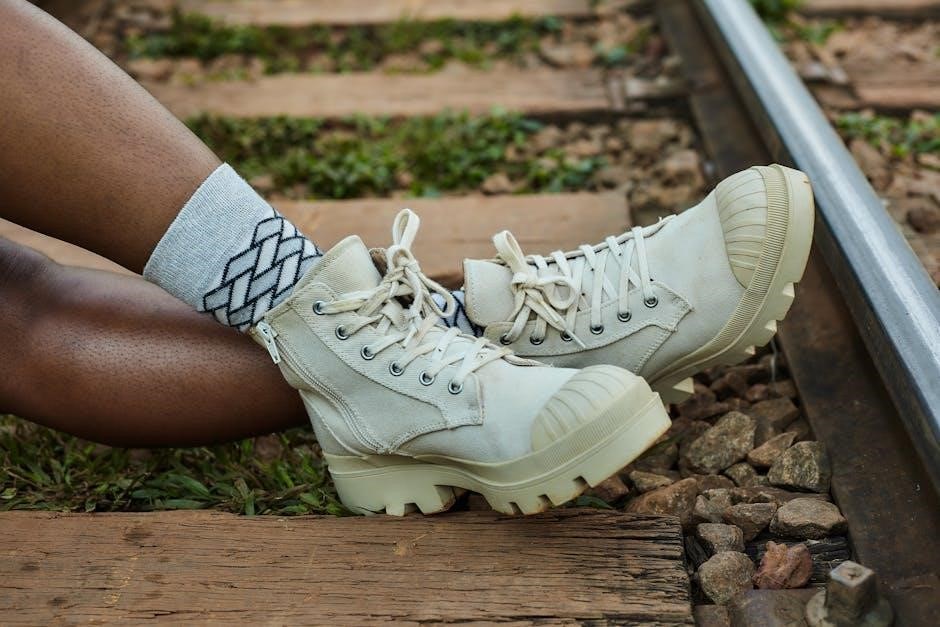This guide is essential for optimal tennis performance and comfort.
It provides measurement tips, size charts, and fit considerations to help you find the perfect shoe.

Importance of Proper Fit in Tennis Shoes
A proper fit in tennis shoes is crucial for comfort, performance, and injury prevention. Ill-fitting shoes can cause foot pain, blisters, and instability, hindering your game. Properly fitted shoes provide optimal support, stability, and mobility, essential for quick lateral movements and sudden stops on the court. They also prevent issues like toe jamming and heel slippage, ensuring a comfortable and secure feel during play. Prioritizing the right fit enhances overall performance and reduces the risk of long-term foot problems, making it a key factor in your tennis success.
Overview of Tennis Shoe Sizing Systems
Tennis shoe sizing systems vary internationally, with the US, European, and UK standards being the most common. These systems differ in how they measure foot length and width, often leading to size discrepancies. While some brands maintain consistent sizing, others may differ slightly. Understanding these systems is key to finding the right fit, especially when shopping across brands or regions. This guide helps navigate these differences, ensuring a seamless transition between sizing standards for optimal comfort and performance on the court.

Understanding Tennis Shoe Sizing Systems
Tennis shoe sizing systems vary by region and brand, with US, European, and UK standards differing in measurements. Accurate sizing ensures comfort and performance.
US Shoe Sizing Standards
US shoe sizing is based on foot length and width, with sizes increasing in increments of 1/3 of an inch. Men’s sizes range from 6 to 16, while women’s range from 4 to 12. The system uses a numerical scale, with half sizes available for a more precise fit. Proper measurement ensures comfort and performance, as ill-fitting shoes can cause discomfort or injury during play. Always refer to brand-specific charts for accuracy, as sizes may vary slightly between brands.
European Shoe Sizing Standards
European shoe sizes are based on the Paris Point system, measuring foot length in centimeters. Sizes range from 35 to 50 for adults, with whole numbers only; This system is consistent across Europe, offering a reliable fit. Unlike US sizing, European sizes do not include half sizes, making conversions straightforward. Proper measurement ensures optimal comfort and performance. Always refer to international conversion charts for accuracy when purchasing from European brands or comparing sizes across regions.

UK Shoe Sizing Standards
UK shoe sizes are similar to US standards but differ slightly in measurements. They are based on the length of the foot in inches, with sizes ranging from 3 to 15 for men and 1 to 9 for women. The UK system includes half sizes, providing a more precise fit. When converting from US or European sizes, it’s crucial to use a reliable conversion chart to ensure accuracy. Proper sizing ensures comfort and performance, especially for activities like tennis, where fit is critical for stability and movement.
Comparing International Sizing Systems
International shoe sizing varies significantly across regions. US, European, and UK systems differ in measurements and size labels. For instance, a US men’s size 9 is equivalent to a European 42 or UK 8; These discrepancies make direct comparisons challenging. To ensure a proper fit, use a conversion chart tailored to your region and brand. Understanding these differences is crucial for online shoppers, as sizes may not align universally. Always refer to brand-specific charts for accurate conversions and a comfortable fit.
How to Measure Your Foot Accurately
Use a ruler or tape measure to determine foot length and width. Stand on paper, mark the longest toe and heel, and measure for precise sizing.
Materials Needed for Measurement
To measure your foot accurately, you’ll need a ruler or tape measure, paper, a pen, and a flat surface. Wear the same socks you plan to use with your shoes. Place your foot on the paper, mark the longest toe and heel, and measure the length and width. Use a chair for support if needed. Measure both feet, as they may differ slightly, and use the larger foot’s measurements for the best fit. This ensures a precise and comfortable shoe size.
Step-by-Step Foot Measurement Guide
Place your foot on a flat surface with the heel against a wall.
Mark the tip of your longest toe and the back of your heel on the floor.
Measure the distance between these two points for length.
For width, measure the widest part of your foot, typically the ball.
Record both measurements and compare them to a size chart.
Ensure to measure both feet, as they may differ, and use the larger foot’s measurements for the best fit.
Tips for Ensuring Accurate Measurements
Measure your feet at the end of the day, as they tend to swell slightly.
Wear the same type of socks you plan to use with your tennis shoes.
Use a ruler or tape measure to ensure precise length and width readings.
Stand up straight while measuring to maintain natural foot positioning;
Double-check your measurements by repeating the process for both feet.
Consider using a printable shoe size chart for cross-referencing your size across different brands.
Accurate measurements are key to finding the perfect fit for optimal comfort and performance.

Factors Affecting Tennis Shoe Fit
Foot shape, width, and court surface influence shoe fit.
Proper sizing ensures comfort, stability, and performance during play.
Accurate measurements and brand-specific sizing are crucial for the best fit.
Foot Shape and Its Impact on Fit
Foot shape significantly affects how tennis shoes fit.
Players with wider or narrower feet may need specialized sizes.
Some brands offer extended widths to accommodate different shapes.
Measuring both feet ensures the best fit, as size can vary between feet.
Proper fit prevents discomfort and enhances performance.
Using size charts and brand-specific guides helps match foot shape to shoe design.
Accurate measurements are key to optimal comfort and support during play.
Importance of Shoe Width
Shoe width is crucial for comfort and performance.
Narrow or wide feet require specific fits to avoid discomfort.
Ill-fitting widths can cause blisters or restrict movement.
Brands offer options like X-Narrow to XX-Wide.
Measuring foot width ensures proper fit.
Consult size charts for accurate width selection.
Proper width enhances stability and mobility on the court.
Ignoring width can lead to poor performance or injury.
Always consider width when choosing tennis shoes.
Court Surface and Fit Considerations
Different court surfaces require specific shoe fits.
Clay courts demand lateral support and durability.
Hard courts need cushioning for impact.
Grass courts require traction and flexibility.
Shoe fit must adapt to these demands.
Tighter fits may be needed for stability on clay.
Looser fits can provide comfort on hard surfaces.
Proper fit ensures optimal performance and injury prevention.
Always consider court type when selecting shoes.
Try shoes with socks you plan to wear.
Ensure enough space for toes to move comfortably.
How to Choose the Right Tennis Shoe Size
Choosing the right size ensures comfort and performance.
Measure your feet accurately and use size charts.
Consider foot width and court surface.
Try shoes with intended socks for the best fit.
Trying On Shoes: What to Look For
When trying on tennis shoes, ensure a comfortable fit with enough room for toes to move.
Check for a snug heel and proper alignment of the foot.
Avoid shoes that feel too tight or cause discomfort.
Wear the same type of socks you plan to use during play.
Leave about a thumbnail’s space between your longest toe and the shoe’s end.
Walk around to ensure stability and no slipping.
The shoe should feel supportive without restricting movement.
The Ideal Fit: Checklist
The ideal fit ensures comfort and performance.
Check for a snug heel and proper foot alignment.
Allow a thumbnail’s space between your longest toe and the shoe’s end.
Ensure the shoe isn’t too tight or restrictive.
Wear the same socks you plan to use during play.
Walk or run to test stability and support.
The shoe should feel comfortable immediately, with no breaking-in needed.
Opt for a glove-like fit that allows natural toe movement.
Ensure the width matches your foot shape for optimal comfort.
When to Size Up or Down
Size adjustments are crucial for comfort and performance.
If your toes feel cramped or the shoe slips, consider sizing up.
If the shoe feels too loose or unstable, size down.
Borderline sizes? Opt for a snug fit for lateral support or a slightly looser fit for comfort.
Always try shoes in the afternoon, as feet swell during the day.
Use brand-specific size charts, as sizing can vary between brands.
Ensure the fit allows for natural toe movement without compromising stability.

Shoe Size Conversion Guide
Convert sizes between US, European, and UK standards.
Use charts to match your size across brands.
Ensure accurate fit by referencing international sizing systems.
Perfect for global shopping or brand switches.
Converting Sizes Between Brands
Shoe sizes can vary significantly between brands due to differences in sizing standards and fit preferences. To ensure accuracy, use a size conversion chart specific to each brand. Some brands offer tools to compare their sizes with others, while others provide detailed fit guides. Always refer to the brand’s official sizing chart for the most reliable conversion. This helps in maintaining consistency and comfort, especially when switching brands or shopping internationally.

International Size Conversion Chart
An international size conversion chart is a valuable tool for comparing shoe sizes across different regions. It allows you to translate your US size to European, UK, or other standards seamlessly. For example, a US men’s size 10 often corresponds to a European size 43 or a UK size 9. This chart is particularly useful for online shoppers purchasing from international brands. While general standards exist, slight variations may occur between brands, so always refer to the specific brand’s sizing guide for accuracy.
Common Mistakes to Avoid
- Assuming size consistency across brands without checking specific sizing charts.
- Not considering foot width, leading to poor fit and discomfort.
- Ignoring the importance of proper fit for performance and injury prevention.
Assuming Size Consistency Across Brands
One common mistake is assuming shoe sizes are consistent across brands. However, sizing varies significantly due to different measurement standards and brand-specific fits. For example, a size 10 in one brand might not match another. Always check the brand’s size chart and measure your feet regularly, as foot size can change over time. Using conversion tools or comparing sizes between brands can help avoid this error. Ignoring this step may lead to discomfort, poor performance, or the need for returns.
Not Considering Foot Width
Ignoring foot width when selecting tennis shoes can lead to discomfort and poor performance. Proper fit requires considering both length and width. Narrow or wide feet may cause blisters or instability. Always check size charts for width options, as brands often offer varying fits. Failing to account for width can result in shoes that are too tight or too loose, affecting mobility and support. Use brand-specific sizing guides to ensure the best fit for your foot shape and width, avoiding common mistakes that hinder performance.
Ignoring the Importance of Proper Fit
Overlooking proper fit can lead to discomfort, blisters, and reduced performance. Shoes that are too tight restrict movement, while those too loose cause instability. Proper fit ensures optimal support, stability, and mobility during play. It’s crucial for injury prevention and comfort. Always prioritize accurate measurements and try shoes on if possible. Proper fit enhances performance and prevents foot issues, making it essential for any tennis player to invest time in finding the right size and fit for their needs.

Tennis Shoe Size Chart
This chart provides a detailed guide for men’s, women’s, and junior sizes, helping you find the perfect fit based on foot length and width measurements.
Men’s Tennis Shoe Size Chart
The men’s tennis shoe size chart offers a detailed guide to help determine the perfect fit. Sizes typically range from 6 to 16, with widths varying from narrow to extra-wide. To use the chart, measure the length of your foot in inches and match it to the corresponding size. Ensure there’s about a thumbnail’s space between your longest toe and the shoe’s end. Consider factors like foot shape and brand-specific sizing, as some brands may differ slightly. Proper fit ensures comfort and optimal performance on the court. Always consult the chart for accurate sizing.
Women’s Tennis Shoe Size Chart
The women’s tennis shoe size chart provides a comprehensive guide for finding the ideal fit. Sizes generally range from 5 to 12, with widths from narrow to wide. Measure your foot length and compare it to the chart for accurate sizing. Ensure there’s a thumbnail’s space between your longest toe and the shoe’s end. Consider factors like foot shape and brand-specific variations, as sizes can differ slightly. Proper fit is crucial for comfort and performance during matches. Use the chart to select the right size for optimal support and mobility.
Junior Tennis Shoe Size Chart
The junior tennis shoe size chart is designed for young players, offering sizes from 1 to 6 in youth sizes. Measure the foot length and ensure a comfortable fit with a small space for toes. Width options vary, and proper fit is essential for support and stability. Use the chart to match foot length to the correct size, ensuring optimal performance and comfort during play. Accurate sizing helps prevent discomfort and enhances mobility on the court for growing feet.

Tips for Online Shoppers
Use size charts effectively and read reviews for fit feedback to ensure the best online shopping experience for tennis shoes.
Using Size Charts Effectively
Using size charts effectively ensures a proper fit when shopping online. Measure your foot length and width using a ruler or tape measure, then compare to the chart. Pay attention to international size conversions and brand-specific variations. For accuracy, measure at the end of the day when feet are largest. Use the chart to cross-reference your size across different brands and standards, ensuring comfort and performance on the court. This step is crucial for avoiding sizing mistakes and finding the perfect fit.
Reading Reviews for Fit Feedback
Reading reviews provides valuable insights into how shoes fit. Many customers share their experiences with sizing, comfort, and performance. Pay attention to comments about tightness, width, and length; Look for patterns, such as consistent reports of shoes running small or large. This feedback can help you make informed decisions, especially if you’re unsure between sizes. Reviews often highlight specific features like arch support or cushioning, which can influence your choice. Use this information to ensure your tennis shoes meet your needs and preferences for optimal comfort and performance.
Proper fit is key to comfort and performance. Use size charts, reviews, and accurate measurements to find your ideal tennis shoe size for optimal results.

Final Thoughts on Finding the Perfect Fit
Proper fit is crucial for comfort and performance in tennis. Use size charts and measurement guides to ensure accuracy. Try shoes in the afternoon, as feet swell during the day. Wear the same socks you plan to use for play. Consider foot shape and width, as they impact fit. Don’t assume consistency across brands—check specific sizing charts. Online reviews can provide valuable fit feedback. Remember, the right fit prevents injuries and enhances performance, making it essential for your game.